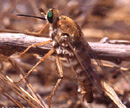 Rhaphiomidas terminatus abdominalis Cazier, 1941
Rhaphiomidas terminatus abdominalis Cazier, 1941
Date of listing: 1993
Federal Status: Endangered
State Status: None
The first fly to receive protection under the Endangered Species Act, the Delhi Sands Flower-Loving Fly was only recently recognized as endangered. This fly is a nectar feeder as an adult, capable of hovering like a hummingbird as it feeds. The adults are active in August and September during which they feed, mate and lay their eggs. The eggs are laid in the sand. Larvae develop entirely below ground and are probably predaceous.
The Delhi Sands Fly is found only in small parts of San Bernardino and Riverside counties, at the eastern edge of the Los Angeles Basin, in areas of fine sandy soil, known as Delhi series sands. While formerly widespread, this habitat has been intensively developed in the past century, primarily for agriculture, though more recently for industry and housing. Only an estimated 2-3% of the original habitat remains undeveloped.
The sites where the fly is currently found all lie on private land and are under constant threat of development. The pace of destruction in this area continues to accelerate. Were it not for the 1993 decision to list the Dehli Sands Fly, all habitable areas would probably have been lost already. The U.S. Fish and Wildlife Service is currently involved in critical negotiations with local governments to protect the remaining areas from disturbance. A habitat conservation plan has been proposed and is currently open for comment. Under this plan eight known or potential sites for the fly would be protected. It would also provide for the establishment of a captive breeding program for the fly.
For further reading:
Cazier, M. A., 1985. A revision of the North American flies belonging to the genus Rhaphiomidas (Diptera: Apioceridae). Bulletin of the American Museum of Natural History 182: 181-263.
Rogers, R. & M.H. Van Dam. 2007. Two New Species of Rhaphiomidas (Diptera: Mydidiae). Zootaxa 1664: 61-68.
US Fish & Wildlife Service – Environmental Conservation Online
Xerces Society species profile

